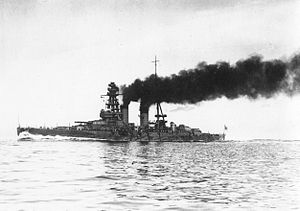 Nagato on her sea trials, 30 September 1920
| |
| History | |
|---|---|
| Name | Nagato |
| Namesake | Nagato Province |
| Builder | Kure Naval Arsenal |
| Laid down | 28 August 1917 |
| Launched | 9 November 1919 |
| Sponsored by | Admiral Katō Tomosaburō |
| Completed | 15 November 1920 |
| Commissioned | 25 November 1920 |
| Stricken | 15 September 1945 |
| Fate | Sunk as a target in Operation Crossroads, 29/30 July 1946 |
| General characteristics (as built) | |
| Class and type | Nagato-class battleship |
| Displacement | 32,720 t (32,200 long tons) (standard) |
| Length | 215.8 m (708 ft) |
| Beam | 29.02 m (95 ft 3 in) |
| Draft | 9.08 m (29 ft 9 in) |
| Installed power |
|
| Propulsion | 4 shafts; 4 × steam turbines |
| Speed | 26.5 knots (49.1 km/h; 30.5 mph) |
| Range | 5,500 nmi (10,200 km; 6,300 mi) at 16 knots (30 km/h; 18 mph) |
| Complement | 1,333 |
| Armament |
|
| Armor |
|
| General characteristics (1944) | |
| Displacement | 39,130 t (38,510 long tons) (standard) |
| Length | 224.94 m (738 ft) |
| Beam | 34.6 m (113 ft 6 in) |
| Draft | 9.49 m (31 ft 2 in) |
| Installed power |
|
| Speed | 25 knots (46 km/h; 29 mph) |
| Range | 8,650 nmi (16,020 km; 9,950 mi) at 16 knots (30 km/h; 18 mph) |
| Complement | 1,734 |
| Sensors and processing systems |
|
| Armament |
|
| Armor |
|
| Aircraft carried | 3 × floatplanes |
| Aviation facilities | 1 × catapult |
Nagato (Japanese: 長門, named after the ancient Nagato Province) was a super-dreadnought battleship built for the Imperial Japanese Navy (IJN). Completed in 1920 as the lead ship of her class, she carried supplies for the survivors of the Great Kantō earthquake in 1923. The ship was modernized in 1934–1936 with improvements to her armor and machinery and a rebuilt superstructure in the pagoda mast style. Nagato briefly participated in the Second Sino-Japanese War in 1937 and was the flagship of Admiral Isoroku Yamamoto during the attack on Pearl Harbor. She covered the withdrawal of the attacking ships and did not participate in the attack itself.
Other than participating in the Battle of Midway in June 1942, where she did not see combat, the ship spent most of the first two years of the Pacific War training in home waters. She was transferred to Truk in mid-1943, but did not see any combat until the Battle of the Philippine Sea in mid-1944 when she was attacked by American aircraft. Nagato did not fire her main armament against enemy vessels until the Battle of Leyte Gulf in October. She was lightly damaged during the battle and returned to Japan the following month. The IJN was running out of fuel by this time and decided not to fully repair her. Nagato was converted into a floating anti-aircraft platform and assigned to coastal defense duties. She was attacked in July 1945 as part of the American campaign to destroy the IJN's last remaining capital ships, but was only slightly damaged and went on to be the only Japanese battleship to have survived World War II. In mid-1946, the ship was a target for nuclear weapon tests during Operation Crossroads. She survived the first test with little damage, but was sunk by the second.